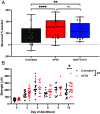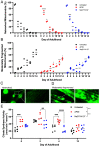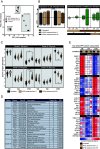Mitochondrial sulfide promotes life span and health span through distinct mechanisms in developing versus adult treated Caenorhabditis elegans
- PMID: 37523525
- PMCID: PMC10410709
- DOI: 10.1073/pnas.2216141120
Mitochondrial sulfide promotes life span and health span through distinct mechanisms in developing versus adult treated Caenorhabditis elegans
Abstract
Living longer without simultaneously extending years spent in good health ("health span") is an increasing societal burden, demanding new therapeutic strategies. Hydrogen sulfide (H2S) can correct disease-related mitochondrial metabolic deficiencies, and supraphysiological H2S concentrations can pro health span. However, the efficacy and mechanisms of mitochondrion-targeted sulfide delivery molecules (mtH2S) administered across the adult life course are unknown. Using a Caenorhabditis elegans aging model, we compared untargeted H2S (NaGYY4137, 100 µM and 100 nM) and mtH2S (AP39, 100 nM) donor effects on life span, neuromuscular health span, and mitochondrial integrity. H2S donors were administered from birth or in young/middle-aged animals (day 0, 2, or 4 postadulthood). RNAi pharmacogenetic interventions and transcriptomics/network analysis explored molecular events governing mtH2S donor-mediated health span. Developmentally administered mtH2S (100 nM) improved life/health span vs. equivalent untargeted H2S doses. mtH2S preserved aging mitochondrial structure, content (citrate synthase activity) and neuromuscular strength. Knockdown of H2S metabolism enzymes and FoxO/daf-16 prevented the positive health span effects of mtH2S, whereas DCAF11/wdr-23 - Nrf2/skn-1 oxidative stress protection pathways were dispensable. Health span, but not life span, increased with all adult-onset mtH2S treatments. Adult mtH2S treatment also rejuvenated aging transcriptomes by minimizing expression declines of mitochondria and cytoskeletal components, and peroxisome metabolism hub components, under mechanistic control by the elt-6/elt-3 transcription factor circuit. H2S health span extension likely acts at the mitochondrial level, the mechanisms of which dissociate from life span across adult vs. developmental treatment timings. The small mtH2S doses required for health span extension, combined with efficacy in adult animals, suggest mtH2S is a potential healthy aging therapeutic.
Keywords: H2S; health span; longevity; mitochondria; transcriptomics.
Conflict of interest statement
M.W. and R.T. have intellectual property (patents) on sulfide delivery molecules and their use. M.W. is a co-founder and CSO of MitoRX Therapeutics, Oxford. S.A.V. and M.R. are co-founders of NemaLife Inc., and the microfluidic devices used in this study have been licensed for commercialization. S.A.V., M.R., and T.A. are named inventors on the microfluidic devices.
Figures






Similar articles
-
Mitochondrial hydrogen sulfide supplementation improves health in the C. elegans Duchenne muscular dystrophy model.Proc Natl Acad Sci U S A. 2021 Mar 2;118(9):e2018342118. doi: 10.1073/pnas.2018342118. Proc Natl Acad Sci U S A. 2021. PMID: 33627403 Free PMC article.
-
The Oxidative Stress Response in Caenorhabditis elegans Requires the GATA Transcription Factor ELT-3 and SKN-1/Nrf2.Genetics. 2017 Aug;206(4):1909-1922. doi: 10.1534/genetics.116.198788. Epub 2017 Jun 9. Genetics. 2017. PMID: 28600327 Free PMC article.
-
Uric acid induces stress resistance and extends the life span through activating the stress response factor DAF-16/FOXO and SKN-1/NRF2.Aging (Albany NY). 2020 Feb 12;12(3):2840-2856. doi: 10.18632/aging.102781. Epub 2020 Feb 12. Aging (Albany NY). 2020. PMID: 32074508 Free PMC article.
-
Hydrogen sulfide in longevity and pathologies: Inconsistency is malodorous.Ageing Res Rev. 2021 May;67:101262. doi: 10.1016/j.arr.2021.101262. Epub 2021 Jan 28. Ageing Res Rev. 2021. PMID: 33516916 Review.
-
Hydrogen sulfide in cell signaling, signal transduction, cellular bioenergetics and physiology in C. elegans.Gen Physiol Biophys. 2013 Mar;32(1):1-22. doi: 10.4149/gpb_2013001. Gen Physiol Biophys. 2013. PMID: 23531831 Review.
Cited by
-
Mechanistic Intimate Insights into the Role of Hydrogen Sulfide in Alzheimer's Disease: A Recent Systematic Review.Int J Mol Sci. 2023 Oct 23;24(20):15481. doi: 10.3390/ijms242015481. Int J Mol Sci. 2023. PMID: 37895161 Free PMC article. Review.
-
Spaceflight Induces Strength Decline in Caenorhabditis elegans.Cells. 2023 Oct 17;12(20):2470. doi: 10.3390/cells12202470. Cells. 2023. PMID: 37887314 Free PMC article.
-
The myosin chaperone UNC-45 has an important role in maintaining the structure and function of muscle sarcomeres during adult aging.Mol Biol Cell. 2024 Jul 1;35(7):ar98. doi: 10.1091/mbc.E23-12-0488. Epub 2024 May 29. Mol Biol Cell. 2024. PMID: 38809582 Free PMC article.
-
Complex Pathophysiology of Acute Kidney Injury (AKI) in Aging: Epigenetic Regulation, Matrix Remodeling, and the Healing Effects of H2S.Biomolecules. 2024 Sep 17;14(9):1165. doi: 10.3390/biom14091165. Biomolecules. 2024. PMID: 39334931 Free PMC article. Review.
References
-
- E. Nash, Health Expectancies at Birth and at Age 65 in the United Kingdom: 2009-2011. Office for National Statistics 1, 1–16 (2014).
-
- Chang S., et al. , Health span or life span: The role of patient-reported outcomes in informing health policy. Health Policy 100, 96–104 (2011). - PubMed
Publication types
MeSH terms
Substances
Grants and funding
LinkOut - more resources
Full Text Sources
Miscellaneous

